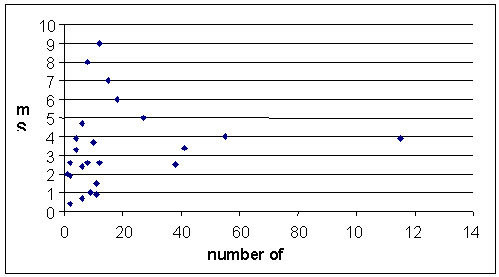
PECULIARITIES OF PATHOLOGY FORMATION IN CHILDREN OF BELARUS EXPOSED TO CHRONIC EFFECT OF SMALL RADIATION DOSES
Nika Gres, M.D., Alexander Arinchin, M.D.
Settlement of Lesnoye, 6, Ap.72, 223052 Minsk, Belarus, tel.2024936.
27.02.2003 Minsk, Republic of Belarus
Research and Clinical Institute for Radiation Medicine and Endocrinology
Abstract
Objective: The study was aimed at the determination of possible clinical effects of long-term radiation effect in small doses following the Chernobyl accident in children of Belarus. Incidence of major diseases was studied in the compared groups with and without a dose load. Peculiarities of disease courses were investigated to reveal atypical age shifts in the pathology. The state of endogenous defense systems (immune, antioxidant, sympathoadrenal) in healthy children with and without a dose load was assessed.
Materials and Methods: Children aged 7-16 years exposed to long-term effect of small radiation doses formed the main group. The control group included children with natural radiation background. The following methods of investigation were used: clinical examination, ophthalmological examination, fibrogastroduodenoscopy with mucosa biopsy, morphological investigation of gastrobioptates, ECG, polyrheography, immunological investigation of the 2nd level, assessment of antioxidant defense and sympathoadrenal systems.
Results: Accumulated during the lifetime dose averaged to 15,4 mSv (3,2-90 mSv). The contribution from the internal exposure was 65-77%. In this group of children, atypical age shifts of pathology were revealed from the side of the organ of vision and the digestive system: the presence of cataracts, high percent of lenthopathies (53,7%), increased cases of gastric mucous atrophy (up to 16%) and intestinal metaplasia (up to 9%). Metabolic form of the cardial syndrome is observed 5 times more frequent as compared with the control. Syndrome of impaired selfregulation of circulation develops. In the group of practically healthy children living under conditions of chronic effect of small radiation doses, significant disorders in immune, antioxidant and sympathoadrenal systems were revealed as compared with the control.
Conclusion: We believe that the results of long-term dynamic observation of children from the representative groups point to the biological significance of chronic effect of low doses of ionizing radiation. For some children from the population, this may be associated with a risk of high damaging effect.
Key words: children, radiation, Chernobyl, morbidity, cataract, immunity, digestive system, circulatory system.
Negative health effects were and remain to be a central problem in all the attempts to limit or mitigate tragical consequences of the Chernobyl accident. Except individual clinical effects of high dose ionizing radiation, there exists a possibility for induction of unfavorable health effects at small radiation doses [1, 2].
Children’s organism as compared with that of adults, is more sensitive to the effects of different unfavorable ecological factors, radiation factor including. “Ecological diagnosis” is associated with particular difficulties, which are connected with the genetic heterogeneicity of the population, different degree of children’s sensitivity to similar anthropogenic doses, a long latent period between the effect and pathological manifestations [3]. On the other hand, ecological factors cause cellular metabolic changes in a child’s body similar to those that occur due to many other reasons.
Clinical manifestations caused by chronic effect of small doses of ionizing radiation practically coincide with manifestations of diseases caused by other reasons.
The incidence of certain diseases in the compared groups with different level of radiation may be used as one of the possibility to ascertain the link between radiation and this or that form of a disease in humans. Ecologically dependent pathology is also determined by the incidence, severity and early appearance of its chronic forms, as well as by the occurrence of unusual forms of diseases more characteristic of the adult population [3].
With a long-term intake of small doses of radionuclides, a “syndrome of endogenic impairment” is developing in a human body, which is not manifested clinically in the first period. It is characterized by increased processes of free radical oxidation, accumulation of underoxidated products of metabolism, decreased immunity and impaired functional state of body systems. In the course of time, chronic diseases occur, acute illnesses become complicated and more severe, autoimmune processes develop, etc. [4].
In this review, I would like to present the results of a long-term observation (1994-2001) over the health status of children’s population in Belarus exposed to a chronic effect of small radiation doses. Taking into account the above mentioned, in order to
assess clinical consequences of the radiation effect, the following tasks were considered:
- to study the incidence of some diseases in compared groups of children with a dose load and without it;
- to reveal possible atypical age shifts in pathology in children from the representative group;
- to assess the state of endogenous defense systems (immune, antioxidant, sympathoadrenal) in healthy children with and without a dose load.
Materials and methods
To assess the dynamics of primary morbidity in children population, intensive morbidity indices were used according to the data of the Belarusian Chernobyl Registry. The data on the children from the 3d group of primary control of the Chernobyl Registry were analysed. The 3d group of primary control includes children residing in zones of immediate and subsequent relocation and those relocated from these zones. In 1993 the number of these children was 17.332, and in 2000 – 14.601.
The diseases and pathological conditions diagnosed according to the ICD-9 in children aged 0-14 years were evaluated annually during the period of 1993 – 2000.
Morbidity indices were determined per 100.000 children. The data were
compared with primary morbidity of children’s population in the whole of the republic in comparable intensive indices by the years of the considered period.
To determine the trends of primary morbidity dynamics of children’s population, dynamic rows of the morbidity indices were smoothed with the help of the linear regression equation. Extreme trend values of each row were compared with the determination of statistical significance of differences using the Student’s criterion.
To conduct a thorough clinical examination and to assess the peculiarities of the pathology under conditions of low-dose radiation effect, a representative group of children aged 7-16 years (n=425) was formed. Requirements to the group were as follows:
1) permanent residence in geochemical provinces of southern Woodlands;
2) increased content of Cs-137 radionuclides in the body;
3) formation of annual effective dose equivalent of 1mSv and larger per year with the predominant share from the internal radiation.
In the observed micropopulation, the annual effective dose equivalent ranged from 1 to 9.7 mSv (Fig.1).
Accumulated total dose equivalent was, on the average, 15.4 mSv and ranged from 3.2 to 71 mSv. In some children it reached 85 – 90 mSv. The main contribution (65 – 77%) to the total dose was from the internal exposure due to incorporation of Cs-137 radionuclides. The control group included 180 children of similar age from rural areas of northern Lakelands.
The study included the following procedures:
- examination by a pediatrician, neuropathologist and otolaryngologist;
- ophthalmological examination;
- investigation of blood cells using hematological automatic blood analyzer, “Technicon H-1”, USA;
- endoscopic gastric and duodenal investigation, mucosa biopsy and histological study of gastrobioptates;
- ultrasound examination of the thyroid gland, abdominal organs and kidneys;
- ECG, cardiointervalography;
- determination of parameters of central and peripheral hemodynamics at the initial state, orthostatis and after physical exertion using polyrheography technique;
- immunological study of the second level;
- assessment of the processes of lipids peroxidized oxidation and the antioxidant defense system;
- study of catecholamines base excretion with urine by fluorometric technique.
To assess the peculiarities of adaptation possibilities under conditions of low radiation effect, 2 groups of practically healthy children were formed:
1) from those living in southern Woodlands under conditions of low radiation doses (n=315);
2) from those living in northern Lakelands at the territory with natural radiation background (n==125).
The results of the comparative analysis of intensive indices of primary morbidity showed that circulatory, digestive and urogenital system diseases in children affected by the Chernobyl accident exceeded the corresponding republican indices with high level of significance (Fig.2, 3, 4).
Of nosological forms of diseases, the incidence of chronic and recurrent bronchitis, chronic gastroduodenitis and urinary tract infections was significantly the highest in the given group of children (Fig. 5, 6, 7).
There were no significant differences in the rate of other registered nosological forms of somatic and infectious morbidity in compared groups of children during the period under study.
While assessing the peculiarities of the pathology in children of the formed representative group under conditions of low dose radiation, the following significant differences were revealed.
First of all, it concerns the organ of vision. As a result of the conducted ophthalmological examination of 135 children from the main group, primary cataract was diagnosed in 3 children of 11, 12, and 15 years old. Their accumulated exposure dose accounted to 15, 17 and 26 mSv, respectively.
Assessment of lenticular changes, which were classified as lensopathies, revealed the following significant (p<0.05) differences as compared with the children from the control group (n=92). The occurrence of lensopathies in both lenses was observed in children from the main group in 53,7±4,3% cases versus 29,3±4.7% in the control. Multiple opacities (more than 6) occurred in the main group in 24,6±3,7% cases versus 8,7±2,9% in the control.
With an increase of Cs-137 activity level in the body, the total number of lensopathies of both lenses is growing (Fig. 8).
Three individual dynamic ophthalmological examinations conducted with an interval of 1 year demonstrated advanced lensopathies in 42.9% of children with Cs radionuclide incorporation.
The next peculiarity of the pathology formation in children with Cs-137 incorporation according to the data of 1994-`1995, is a high percent of cases with gastric mucosa atrophy (16,4±2,6%) and intestinal metaplasia (5,4±1,6%) observed in chronic gastritis development versus 2,7±1,6% in the control.
Assessment of these indices during the repeated examinations (1999-2000) revealed that the incidence of atrophy was registered in dynamics in 12±3,8% of the observed children (n=105), intestinal metaplasia – 9,3±2,8%. It should be noted that these changes were stable during the first and second examination in children born 1985-1986 (Fig.9).
Concerning the cardiovascular system, the obtained findings testify to the formation of a syndrome of impaired selfregulation of blood circulation.
Blood circulation index in children from the main group exceeded significantly similar index in the control and increased by the second examination. To preserve the arterial pressure at the normal level, the peripheral resistance index decreased simultaneously (Table 1). This determines the development of hyperkinatic type of blood circulation when the level of the arterial pressure is maintained mainly due to increased work of the heart on the background of insufficient tone of arterial vessels. The given type of blood circulation is less economic as to energy requirements and does not correspond to physiological peculiarities of children’s age.
The results of the study of the dynamics of peripheral blood circulation indices according to finger rheovasography, show the initially decreased finger pulse blood volume and finger pulse blood filling in children from the main group and a decrease of these indices in dynamics. The given finding may testify to a decrease of tissue perfusion.
The analysis of data from the electrocardiographic investigation in the main group (n=133) demonstrated that metabolic form of cardial syndrome during the first examination equaled to 14,93±3,1% versus 3,2±1,3% in the control (n=186), p<0,05. Follow-up of these children in dynamics recorded increased indices in the main group up to 23,3±3,7%, in the control – up to 6,9 ±3,4% (p<0,05).
And, finally, I’ll try to answer the following question: Why do children exposed to long-term radiation effect with low radiation doses get sick more frequently and more severely?
Assessment of the state of endogenous defense systems in healthy children revealed significantly that in children from southern Woodlands, different pathologies were observed more frequently. The incidence of T-lymphocytopenia syndrome in this group reaches 47,8±2,8% versus 26,0±3,9% in the control (p<0,05). Activity of lipid peroxidation processes (according to the level of malonic dialdehyde in erythrocytes) is significantly higher in children from southern Woodlands as compared with the control (14,5±1,31mkMol/ml and 5,5±0,25 mkMol/ml, accordingly). Basal level of major hormones of the sympathoadrenal system (adrenaline, noradrenaline and dophamine) is significantly decreased in children from southern Woodlands as compared with the control group (Table 2).
Discussion
The results of a long-term medico-ecological monitoring of children of Belarus affected by the Chernobyl accident testify to the formation of a micropopulation with increased level of Cs-137 cont±ent in the body. It does not matter what kind of exposure formed the dose (internal or external): it is the value of a dose that matters. Though, another thing is of importance. It is necessary to know the mechanisms that determine the formation of a dose load and its effect on the human health. Can we neglect the fact that following 15 years after the accident, the children continue to accumulate radionuclides? If relatively permittable annual effective dose equivalent in the republic equals to 1mSv per year, then the accumulated during the life dose may account to about 70 mSv. How can we admit that such a dose has a child of 10-14 years old and is it harmless? Children with increased content of radionuclides in the body were revealed at the territories with low density contamination with Cs-137 (1-5 Ci/sq.km), which were considered to be safe for living. Though, the peculiarities of peat soils of Belarusian Woodlands determine an increase (5-15-fold) in the coefficient of Cs-137 transition from the soil to the plants, then to foodstuffs and through the biological chain to a human being.
We consider that children with increased radionuclide content in the body can be assigned to a group of radioecological risk. Special attention should be paid to those born 1985-1986 and affected by radiation at the time of the accident during the most critical periods of their development (intrauterine and early postnatal).
It is necessary to assess the influence of this dose load to a human health. A search for an “instrument” (method) allowing an objective answer to a raised question is important. Controversial character of the available information is accounted by the use of linear “dose-effect” dependence, which is applied while estimating practically all forms of pathology. At the same time, biological effects occurring with relatively small but protracted radiation effect are based on a non-linear non-threshold model: before reaching a certain concentration of ecopathogenes in the environment, their effect does not depend on a dose [3].
While conducting our studies, we took into account that similar clinical effects cause protein deficiency in food, vitamin deficiency, disbalance of microelements and other factors. Therefore, quality assessment of actual nourishment of a child, the content of major vitamins and essential microelements, the presence of chemical toxicants of lead, cadmium and mercury were included into the complex of examination [5, 6]. Taking into account these data, the main and the control groups were formed, which were close as to the characteristics of the given indices. Besides, children’s residence in rural territories and their similar social conditions were also considered. So, taking into account the multifactor analysis as a base for the assessment in the change of a child’s health, we made an attempt to mitigate maximally the effect of a complex of non-radiation agents.
According to the obtained data, a significant increase in the diseases of digestive and circulatory systems is observed in children exposed to protracted effect of small radiation doses in contrast to those living at the territories with natural radiation background. The formation of the pathology, which is not typical for children, should be assigned to unfavorable tendencies of health damage. Regarding the organ of vision, we observe the formation of cataracts and increased lenthopathies. As to the stomach, intestinal metaplasia and gastric mucosa atrophy are revealed significantly more frequently as compared with the control. These changes are characteristic of the people of elderly and old age. At the same time, it is not typical of the analyzed age group and, according to literature data, may testify to an increase of precancerous potential of the stomach.
An assessment of the data of histological study of gastric mucosa in dynamics with an interval of 4-5 years, again revealed a considerable percent of children with atrophy and intestinal metaplasia. It should be noted that these changes were stable during the first and second examination in children born 1985-1986. This group of children should be assigned to the group of maximal radiation risk, because a combination of 2 factors is observed here:
1) high level of radiation effect at the time of the accident in the most critical periods of a child’s development (intrauterine and early postnatal);
2) constant excessive radiocaesium intake during a child’s life.
As we have already noted, besides radiation factor, a contribution of some chemical anthropogenes was also studied by us. We speak in particular about lead as most spread ecological toxicant, which was widely used in the process of liquidation of Chernobyl accident consequences [4]. The incidence of atrophy of gastric mucosa in children with chronic gastritis grew with an increase of pathogenic ecological factors in the body. Under the conditions of chronic low dose effect of radiation it amounted to 16,1% . At the same time, in the group of children with increased content of Cs-137, lead and nitrates in the body, this index grew up to 36,8%.
To assess the formed relationship between the acting anthropogenic factor, we have use the Goodmann’s technique based on the assessment of prevalence logorithm [7]. This allowed us to compare the indices having numerical values (specific activity of Cs-137 in the body, the amount of lead and nitrates), and such parameters as age, territory of living, etc. It appeared, for example, that in the zone of radiation control, Cs-137 contributed most to atrophy formation (174%), lead (119%) and nitrates (103%) were less significant.
From the side of the cardiovascular system, the changes at the level of metabolic and functional disorders were recorded in children from the representative group. Significant differences, as compared with the norm, of central and peripheral hemodynamics indices were revealed according to the data of polyrheography, as well as a significant increase in the metabolic form of cardial syndrome according to the ECG data. The formed syndrome of impaired selfregulation of blood circulation and an increase in cardial manifestations of vegetative dystonia up to 67,9% (40,3% in the control) makes a basis for the development with age cardial and cerebrovascular pathology [8].
Assessment of peculiarities of endogenic defence in healthy children exposed to chronic low dose radiation effect revealed a high percent of immune disorders, increased processes of lipid peroxidase and decreased function of the sympathoadrenal system. Changes observed in the systems of adaptation, allow the organism, on the one hand, to correct early responces to the effect of low dose ionizing radiation and, on the other hand, progressing in the course of time, they form the basis for pathology development [9].
We believe that the results of long-term dynamic observation of children from the representative groups point to the biological significance of chronic effect of low doses of ionizing radiation. For some children from the population, this may be associated with a risk of high damaging effect.
Of course, contrary opinions may exist as to the considered problem. The obtained results may be considered in a different way. Though, the need for continuing thorough systematic medical observation of the population of people affected by chronic low dose radiation as children is evident. Therefore, one of the directions of the study dealing with the Chernobyl accident should include the assessment of long-term consequences of irradiation [10].
References
1. Sinnaeve J., Karaoglou A.A. European commission: post-Chernobyl response of health effects. Int J Rad Med 1999; 5: 8-13.
2. Flacus E. N. Opening address of the 2nd International Conference “Long-term health consequences of the Chernobyl disaster”, June 1-6, 1998. Kiev. Int J Rad Med 1999; 1: 5-7.
3. Veltischev Y.E. Ecologically determined health impairments in children. Russian Pediatrics J 1999; 3:7-13.
4.Vasilenko I.Y. Biological effect of nuclear release products. Radiobiology J 1992; 32: 69-78.
5. Pathomorphosis of chronic gastritis in children and adults of Belarus under conditions of ecological effect after the Chernobyl accident. Minsk; 1995.
6. Microelement disorders and the health of children in Belarus following the Chernobyl accident. Minsk; 1997.
7. Apton G. Analysis of conjugation tables. Moscow; 1982.
8. Endoecology of children in Belarus. 15 years following the Chernobyl accident. Minsk; 1995.
9. Alesina M.Y. Formation of radiobiological effects at chronic external and internal exposure of experimental animals in small doses. Int J Rad Med 1999; 2: 92-99.
10. Gofman J.W. Radiation-induced cancer from low-dose exposure: independent analysis. 1st ed. San-Franc., USA, 1990.- 480.
Table 1
Some indices of the central (blood circulation index, peripheral resistance index) and peripheral (finger pulse blood volume, finger pulse blood filling) hemodynamics in children from the main and control groups.
|
Indices |
Control group |
Main group |
|||
|
1st examination |
2nd examination |
1st examination |
2nd examination |
||
|
blood circulation index ,% |
83,041418± 6,265536 |
101,98314± 4,69836 |
103,57641± 5,428298 ** |
125,88022± 7,475221 *,** |
|
|
peripheral resistance index, % |
127,14193± 6,384451 |
113,11432± 4,945189 |
107,29666± 6,881593 ** |
89,716826± 4,432071 *,** |
|
|
finger pulse blood volume, ml |
0,001241± 0,000231 |
0,001616± 0,000291 |
0,000836± 0,00009 ** |
0,000521± 0,000043 *,** |
|
|
finger pulse blood filling, ml/min |
0,107816± 0,019463 |
0,128913± 0,023476 |
0,064849± 0,007067 ** |
0,039002± 0,003559 *,** |
|
Note: * Significant differences within one group in dynamics, p<0,05
Table 2
Indices of the sympathoadrenal system activity in healthy children exposed to chronic low dose radiation effect and in the
control.
Indices |
Control group |
Main group |
|
Noradrenaline , ng/ml |
12,473±1,946 |
9,204±0,594 * |
|
Adrenaline, ng/ml |
8,764±0,782 |
6,636±0,436 * |
|
Dophamine, ng/ml |
111,750±3,641 |
55,177±2,636 * |
Note: * Significant differences between the groups, p<0,05

Fig.1. Distribution of children according to the annual dose equivalent (mSv).

Fig.2.Comparative
dynamics of primary morbidity of the circulatory system diseases in children’s
population (0 – 14).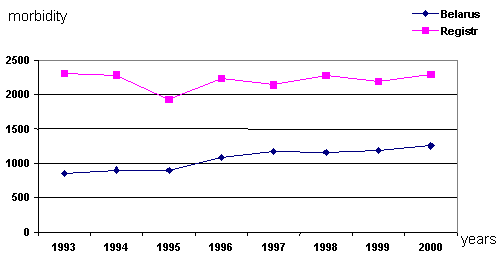
Fig.3.Comparative dynamics of primary morbidity of the urogenital system diseases in children’s population (0 - 14).
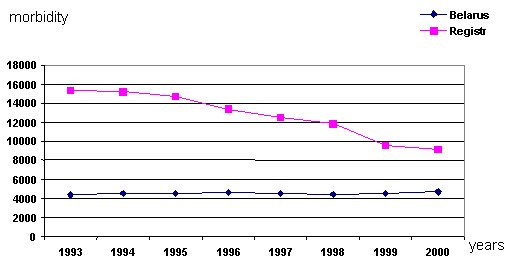
Fig.4. Comparative dynamics of primary morbidity of the digestive system diseases in children’s population (0 - 14).
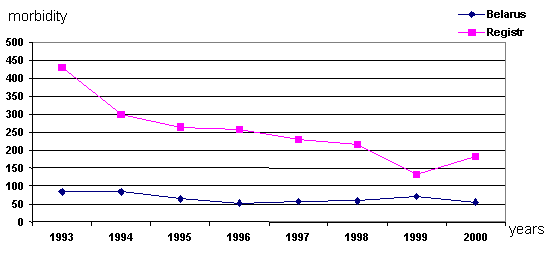
Fig.5.Comparative dynamics of chronic and recurrent bronchitis primary morbidity in children’s population (0 - 14).

Fig.6.Comparative dynamics of chronic gastritis and duodenitis primary morbidity in children’s population (0 - 14).
Fig.7.Comparative dynamics of renal infections primary morbidity in children’s population (0 - 14).

Fig.8. Relationship between the number of lens opacities and the 137Cs body burden in exposed children
Number of Children
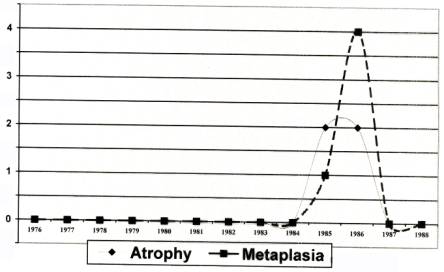
Years
of birth
Fig.9. Revealed new cases of gastric mucous atrophy and metaplasia in children depending on the date of birth